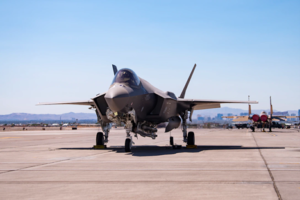
An F-35A Lighting II carrying a B61-12 Joint Test Assembly sits on the flight line at Nellis Air Force Base, Nevada, Sept. 21, 2021. Two F-35A Lightning II aircraft released B61-12 Joint Test Assemblies during the first Full Weapon System Demonstration, completing the final flight test exercise of the nuclear design certification process. (U.S. Air Force photo by Airman 1st Class Zachary Rufus)
Two F-35A Lightnings passed a nuclear training test this year when they dropped a pair of mock B61-12 gravity nuclear bombs. The exercise took place at Nellis Airforce Base in Nevada on Sept 21, 2021. The demonstration is regarded as a graduation flight test for achieving nuclear certification. Stephen Losey of Military.com writes abridged:
A pair of F-35s from Nellis Air Force Base in Nevada released dummy nuclear bombs at a nearby test range this month, moving the advanced stealth fighter closer to carrying the world’s most powerful weapons into combat, the Air Force said Monday.
The flights on Sept. 21 marked the “graduation” test exercise necessary for the Air Force variant of the F-35 to move ahead with what’s called the nuclear design certification process, according to the service’s press release.
It’s still not clear when the F-35A will receive its full nuclear certification allowing it to move from training ranges and dummy bombs to real-world battlefields. But when that happens, the Air Force will have a second stealth aircraft in its fleet that can carry nukes.
“The B-2 [Spirit] bomber was the prominent nuclear-capable stealth aircraft,” Lt. Col. Daniel Jackson, division chief for strategic deterrence and nuclear integration at Air Combat Command, said in the press release.
F-15E Strike Eagle and F-16C and D Fighting Falcon fighters do not have stealth capability but can carry nuclear weapons. The B-21 Raider heavy bomber will also have the capability and is expected to join the Air Force’s fleet in the mid-2020s, according to the latest estimates.
Not all F-35As in the Air Force’s fleet will become nuclear-capable. Only fighters in units with a nuclear mission will receive the hardware upgrades, and the manpower, to be able to carry nukes.
The F-35s in the Nevada test were each armed with a dummy version of the B61-12 gravity nuclear weapon. That nuclear weapon is about 12 feet long and weighs approximately 825 pounds, according to the U.S. Department of Energy.
The Federation of American Scientists wrote in 2016 that its explosive yield can be adjusted up to as much as 50 kilotons, or the equivalent of 50,000 tons of TNT. That is far from the most powerful weapon in the United States’ arsenal, but several times the size of the bomb dropped over Hiroshima, Japan, during World War II.
Joint test assemblies are mock-ups of nuclear weapons that carry sensors and instruments to collect and store data measuring how well they performed, but they contain no nuclear material and cannot produce a nuclear explosion.
Steve Schneider
Latest posts by Steve Schneider (see all)
- New Chinese Electromagnetic Surveillance Leaves “Nowhere to Hide” on Battlefield - March 15, 2024
- Amazon’s Nuclear Powered Data Center - March 7, 2024
- Skunk Works Rolls Out An Engineering Marvel - March 6, 2024
- Future of Airpower Takes First Flight - March 4, 2024
- A War Beneath the Waves – Trillions of Dollars at Stake - February 9, 2024















